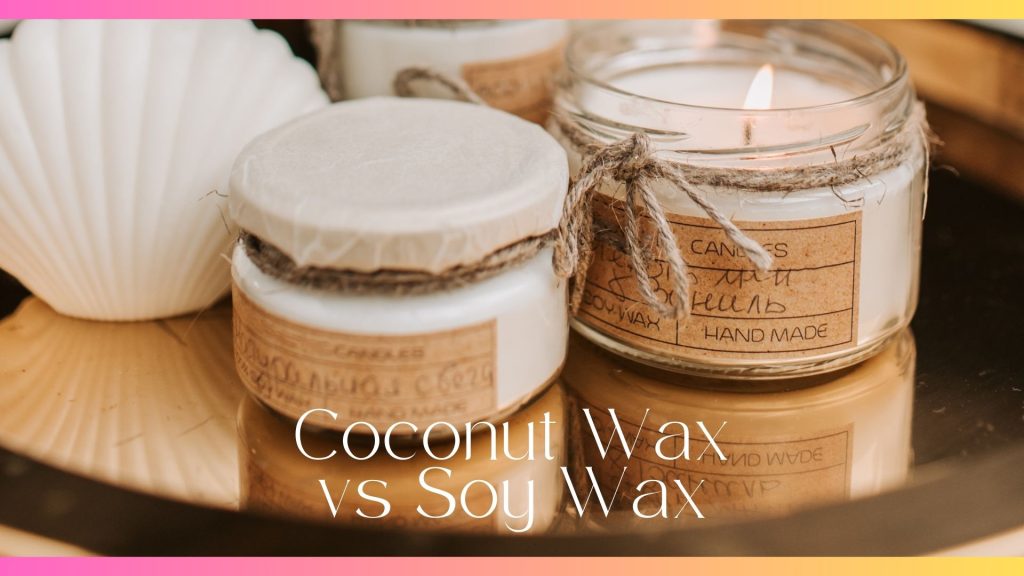Don’t know the difference between beeswax candles vs soy candles? Unsure which one to go with? Here are six major things you should know!
As people become more environmentally conscious, there are growing demands for sustainable and natural alternatives to traditional paraffin candles. There are a few major choices we can go with and it’s always better to understand their key traits to make an informed decision – whether you’re the consumer or a business owner.
In this article, I’ll be sharing six major characteristics that differentiates beeswax candles and soy candles – including their accessibility and impacts on the environment. Read on!
Disclaimer: This post may contain affiliate links. This means I may earn a small commission (at no cost to you) if you sign up for a program or make a purchase using my link!
Related Posts:
- 7 Things To Know – Coconut Wax vs Soy Wax
- 5 Benefits of Soy Candles You Should Know
- Are Soy Candles Bad for the Environment?
Beeswax Candles vs Soy Candles: 6 Things To Know
1. Origins and Composition
Firstly, it’s important for you to know the origins of both types of candles and it’s composition (what it is made of).
Beeswax candles are naturally made from the wax produced by honeybees when constructing their honeycombs. The wax is then harvested from real beehives and undergoes minimal processing before it is used for candle making.
Soy candles on the other hand, are derived from soybean oil that’s both renewable and biodegradable. Soybean oil is extracted by natural soybeans that are cracked and heated to between 60°C and 88°C. It is then rolled into flakes and solvent-extracted with hexanes to produce the oil.

While both beeswax and soy candles are derived from natural sources, their compositions differ, with beeswax being a product of bee activity and soy wax being a byproduct of soybean cultivation.
If you wish to purchase a vegan-friendly candle, soy candles should be your go-to. Beeswax are produced by bees (an animal) hence it is not ideal for vegan consumers.
2. Sustainability and Environmental Impact
Both beeswax candles and soy candles are made from renewable resources, which makes them eco-friendly alternatives to paraffin candles (produced from non-renewable fossil fuels).
Beeswax is a natural byproduct of honey production and does not require additional resources or land use beyond what is needed for beekeeping. They are also are biodegradable and emits minimal pollutants when burned, making them a sustainable choice for environmentally conscious individuals.
Similarly, soy candles utilize soybean oil which are a renewable resource that can be grown sustainably with the right agricultural practices. Compared to traditional paraffin candles, soy candles are biodegradable and produce less soot and harmful emissions – this makes it even more appealing.
3. Scent and Aesthetics
Different candles are made best with different types of scents. So if you’re inclined to a certain type of scent, you’ll need to know if it’s available for the type of candle you’re going for.
A distinguishing characteristic of beeswax candles compared to other kinds of candles is their natural aroma. There’s a subtle honey-like scent derived from the beeswax itself, so you’re getting a warm, sweet fragrance when burned – without the use of any artificial fragrances.
Due to this, there are limited options of scents that can be paired perfectly with beeswax candles. You’ll also find less product options in the market, but popular options would be vanilla, grapefruit, orange and cocoa – these are warm scents of its own!
In contrast, soy candles are widely preferred by candle makers as they can be infused with a variety of essential oils and fragrances. It is more versatile in terms of scent pairings compared to beeswax candles hence it is a more practical option when customizing aromas people love. You can find soy candles that are made in a wide range of scents, from floral and fruity to spicy and woody.
When comparing aesthetics, beeswax candles are naturally yellow in color while soy candles are white (unless dyed). It is entirely up to you which you prefer as both have a natural, creamy appearance that adds elegance to any room. I know this as a homebody myself!

4. Burn Quality and Performance
When it comes to choosing the right candles, a major factor to consider would be the burn quality and performance e.g. how it burns and how long. Both beeswax and soy candles offer excellent characteristics that contribute to a superior candle burning experience.
Beeswax candles have a higher melting point (62°C to 64°C), this in turn results in a slower and longer-lasting burn compared to other candle types. It usually produces a bright, steady flame that emits a warm, golden glow. This is perfect for creating a cozy and inviting atmosphere when you have guests coming over!
When soy candles are properly formulated and burned, there is minimal soot and smoke so you don’t have to worry about compromising air quality or safety. Soy candles also have a longer burn time (20-25 hours for 100ml) compared to paraffin candles.
5. Price and Accessibility
Price plays an important factor when purchasing the type of candle for your home or space, especially if you use it regularly.
Generally, soy candles are more affordable and widely available compared to beeswax candles. It is less expensive to produce and takes less time compared to waiting for beeswax collection from beehives – mass production plays a part.
Soy wax and soy candles are budget-friendly options for business owners and consumers, respectively. Even as a consumer, soy candles is easily accessible and can be found in a variety of retail outlets, including supermarkets and online marketplaces.
Beeswax candles, while less common and often pricier than soy candles, can still be found from artisanal candle makers, beekeepers, and specialty retailers.
There’s definitely a growing market for both as eco-conscious consumers look for alternatives to paraffin candles. I love saving money as much as I spend, so as a consumer, soy candles make a practical purchase.
6. Considerations for Allergies and Sensitivities
With any product that’s made from natural ingredients, there are risks of allergies and sensitivities. Personally, I have not faced any issue but it can be worrying when I have family or friends over.
If you have allergies or sensitivities to certain ingredients, such as pollen or soy, you’ll need to consider potential allergens when selecting the right candles for you.
Beeswax candles may contain trace amounts of pollen, propolis, or bee-related allergens, which could trigger allergic reactions in sensitive individuals.
Soy candles on the other hand, may contain soy protein residues. This could pose a risk for individuals with soy allergies. It’s best that you carefully review product labels for ingredient lists and conduct patch tests before using candles with unfamiliar ingredients – especially if you have history of allergies or sensitivities.

Frequently Asked Questions (FAQs)
Generally, soy candles are cheaper in price compared to beeswax candles. Soy wax is easily produced thus making it more accessible in the market. Beeswax candles rely on the harvest of wax from beehives so it takes a longer time and requires more work.
When comparing beeswax vs soy wax for burn time, beeswax is able to burn longer for the same amount of wax. Beeswax candles have a higher melting point which means it’s harder for it to melt compared to soy wax. This leads to a longer burn time and a more even burn.
Bottom Line
Choosing between beeswax candles or soy candles doesn’t have to be hard. Both offer unique qualities and benefits so whether you’re going for affordability or sustainability, it’s always best to try them out yourself.
Everyone has different individual preferences and while mine would be soy candles, you should choose one that best suits your current needs and lifestyle. Remember to have an eco-friendly and enjoyable candle experience!


